Part 5
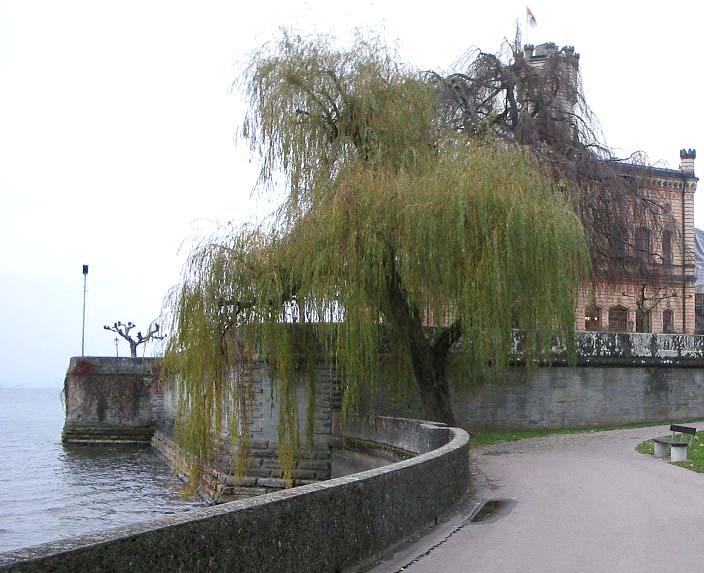
(Photo credit by Gary Dahl)
Before we leave the resort town of Langenargen for next year's ETF, here's another photo - this time of the Bodensee (Lake Constance) and Schloss Montfort. After we made our farewells to all the wonderful people at the ETF, Christian collected our little band of American tourists, put on his tour-guide hat, and drove our minibus a few miles west to Friedrichshafen, where the ferry departed for Romanshorn in Switzerland.

Leaving Friedrichshafen and crossing the Bodensee.
At Friedrichshafen, we discovered the Zeppelin Museum (Wow! Cool!). Next year, we plan to spend a little time there - it turns out that this is the original home of the Zeppelin factory, and the Zeppelins made their majestic first flights sailing across the Bodensee. Those of you who know cars know about ZF transmissions - I bet you didn't know that ZF got their start making reduction gearboxes for Zeppelin aviation motors, and later branched out to automobiles. (On the way to Largenargen, we drove by the ZF factory, and it had "Zeppelin" in gigantic letters on the side of the factory.)

After debarking from the ferry and passing through the town of Romanshorn on the Swiss side of the lake, we had a long, leisurely drive through the Swiss countryside back to Zurich. We saw rolling countryside, traditonal-style Swiss farmhouses, small towns here and there, each with its distinctive church steeple with a clocktower. (I'm not sure, but mechanical clocks themselves may have been invented in this part of the world, and saw their first use on church steeples, announcing the times of services.)
We even saw a tiny little cart pulled by two ponies, and carrying Father Christmas and a woodsman dressed in brown leather. A local Swiss custom, apparently, and just one of many sights on the way back to Zurich.
One difference between Swiss/German country towns is the relative prosperity compared to the US countryside, which has been devastated by corporate agribusiness buying out family farms and Wal-Mart bankrupting small-town retailing. By contrast, the Swiss and Germans appear to have a policy of encouraging new factory construction in the countryside, since quite a few of the little towns had crisp new light-industry factories about a kilometer or two outside the towns, easy bicycling distance for the townspeople, but not right in town itself. Big-box retail stores were nowhere to be seen - just small-town businesses in locations that were obviously the same for generations or even centuries.
Instead of the de-industrialized appearance of the "Rust Belt" and much of rural America, with shells of abandoned factories and dusty stores with boarded-up windows, this part of rural Europe looks very different - much more prosperous, with successful integration of light industry, farming, and traditional small communities. Preservation of rural life is obviously a priority in this part of the world.
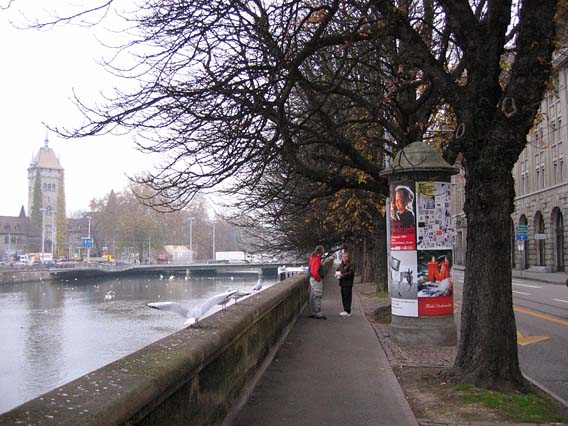
Once we returned to Zurich, Steve Bench departed on his return to sunny San Diego, and our party was down to Gary Pimm (left), John Atwood (right), and myself. We had a few days in Zurich to see the sights, so we bundled up and started exploring. The photo shows us walking along Neumuhlequi avenue, only a few blocks away from the Eidgenossische Technische Hochschule Zurich, or as it's known locally, the ETH. This 150-year-old university, and its place in the world, have a little bit of history ...
Albert Einstein and his friends walked down this same avenue when he was a student at the ETH in Zurich. Carl Jung also studied in Zurich, taught at the ETH from 1933 to 1941, and established the C. G. Jung Institute in Zurich 1948.
Another Swiss, Albert Hofmann, studied chemistry at the University of Zurich from 1926 to 1929, and later went on to discover LSD at Sandoz Laboratories in 1943. Albert Einstein, C.G. Jung, and Albert Hofmann couldn't seem more different - but all three explored and radically transformed our understanding of physics, cosmology, psychology, and the inner and outer realms of consciousness and the Universe.
These revolutions created by these three men were so profound that politics, religion, and mass consciousness ("common sense") in many parts of the world have not only failed to come to grips with the depth of the transformation implied by these discoveries - but are fighting a vigorous battle to reject them and to turn the clock back to the predictable and well-ordered little world of the Nineteenth century.
Makes you think, doesn't it? It's a little sobering to realize that all three men - explorers of inner and outer space - walked along the same tree-lined avenues as our trio of West Coast audiophiles. Although this little corner of Switzerland looks very much the same as it did a hundred years ago, the mental world we inhabit is much different.
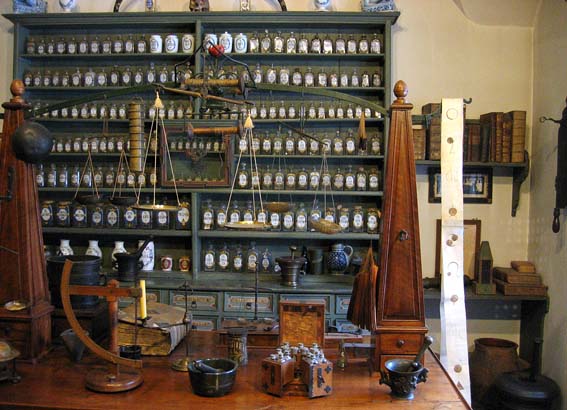
A room-sized recreation of a late-medieval Apothecary shop inside the Swiss National Museum. (You can see the entrance to the museum as the ivy-covered tower on the other side of the river in the street scene above.)
This is a wonderful museum, well worth a visit if you are in Zurich, with a remarkable collection of medieval and Renaissance art, artifacts, and even complete furnished rooms that date from the 15th, 16th, and 17th centuries. The only downside was a policy of "no photography", something I discovered about 15 minutes after taking this picture. Oh well, at least I didn't use a flash, so no harm done.
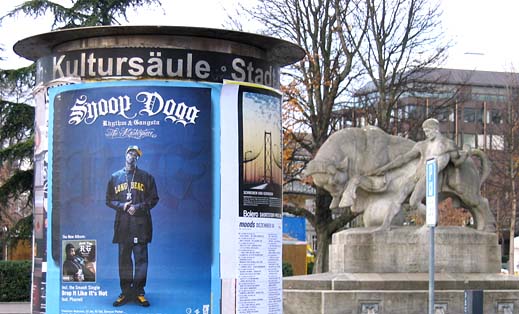
From the sublime to the ridiculous: another juxtaposition of new and old Europe, right alongside each other. Rapper Snoop Doggy Dog, next to 19th-century neoclassical nude sculpture (note absence of Ashcroft fig leaf). The whole stance towards culture is different in Switzerland - even the occasional grafitti appears to be subtly influenced by the local art community.
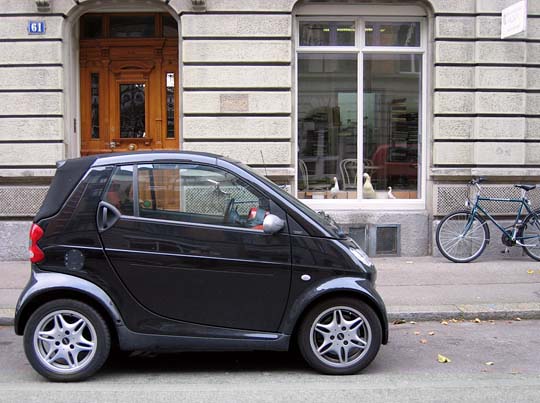
A Smart Car, next to the elegant doorway of a Swiss graphics arts house, next to the ubiquitous bicycles of Zurich. Hmm ... if that's a Smart Car, then what's a Cadillac Escalade or Hummer H2? Then again, gas prices of US$5 to $6 a gallon probably have something to do with the fact I didn't see a single SUV the whole time I was there - the cost of driving one across town would be astronomical, not to mention the impossibility of parking a vehicle bigger than a European delivery truck.
The Smart Car is so short, you'd see two of them parked in one parking spot, or parked nose-in a normal parallel parking spot. When I sat in one at the ETF, amazingly, it was quite roomy, as roomy as my midsize Acura TL back home - and I'm 6 foot 2 inches, not a small guy. I'm told these entertaining little-but-luxurious cars (and they are very deluxe inside) will imported into Canada next year. God help them if they get wedged between a Kenworth 18-wheeler and a Ford F250 pickup truck with camper on back.

I couldn't read a word - well maybe one or two - of the sign, so I'm guessing this is a puppet show. These must be popular; I saw them in downtown Zurich, in the train station (where this was taken), and in Munich as well. They're probably for children, but maybe adults as well, and I'm guessing incorporate local Christmas folktales. Maybe European children aren't as entranced by video games and television as media-saturated Americans, so children and their parents can still enjoy a traditional form of entertainment.
European TV has a different feel than American TV, not as saturated with fast-moving NeuroLinguistic Programming (NLP - look it up on Google) subliminal techniques as US broadcasting. European TV news doesn't seem to be based on the fear/buy cycle of US television, where car crashes, murders, rapes, abductions, floods, fires, and other forms of mayhem rapidly alternate with soothing prescription-drug advertisements. The fear/buy cycle is almost unavoidable on US media - overhyped sensational stories with little relevance to anyone's lives cycle back and forth with titillating soft-focus advertising images. Even PBS is accepting corporate "sponsorship" and is gradually adopting more corporate-friendly programming. Whether Europe falls into this pattern remains to be seen.
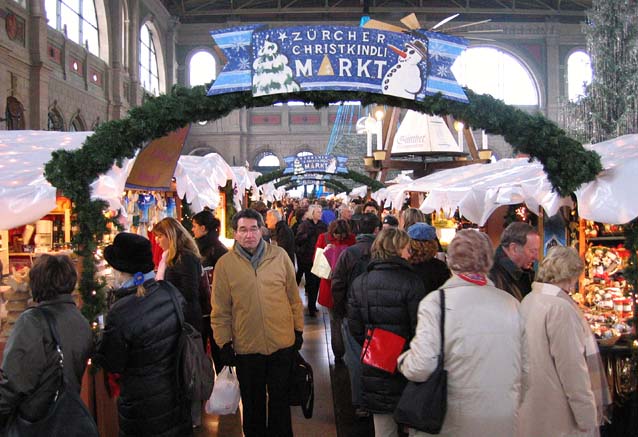
The Christmas market in the huge Zurich train station. This was taken on the first week of December, and as you can see, plenty of shoppers are buying trinkets and presents from the local artisans.
Gary and bought our tickets for Munich at this station, and I asked the ticketseller (who spoke flawless English) what time we should arrive at the station for the 9:30AM train to Munich. With just the slightest flicker of a smile, the ticketseller replied, "9:29 and 45 seconds, sir" which cracked up Gary Pimm. With that kind of set-up, the next day when we caught the train, I watched the clock on the station platform - the train started moving at 9:31 and zero seconds (it probably took a minute to close the doors to the train). It's true, the Swiss are precise.
Text and Pictures © Lynn Olson 2004, except where noted.